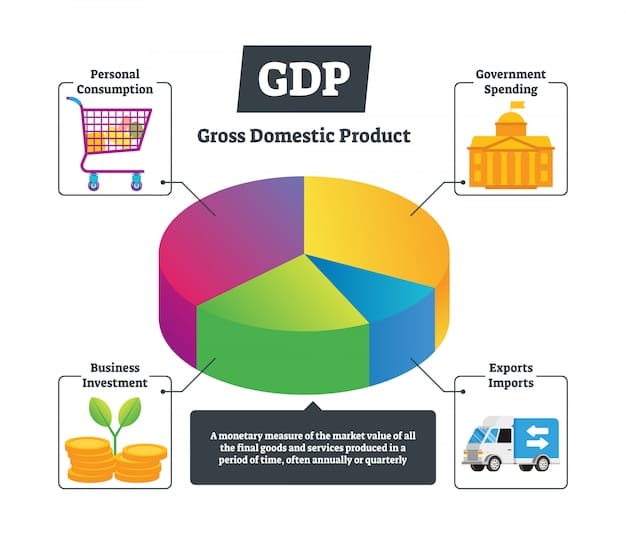Employee Stock Purchase Plans (ESPPs): Your Guide to a 15% Discount

Employee Stock Purchase Plans (ESPPs) offer a fantastic opportunity to acquire company stock at a discounted rate, typically around 15%, allowing employees to build equity and potentially benefit from the company’s growth, but it requires understanding of enrollment, holding periods, and tax implications.
Do you want to own a piece of the company you work for, and even better, at a discount? Employee Stock Purchase Plans (ESPPs): How to Get a 15% Discount on Company Stock might be just the ticket! ESPPs allow employees to purchase company stock at a reduced price, often 15% below market value. Let’s dive into how these plans work and how you can make the most of them.
What is an Employee Stock Purchase Plan (ESPP)?
An Employee Stock Purchase Plan (ESPP) is a company-sponsored program that enables employees to buy company stock at a discounted price. It is a valuable benefit, offering the potential for financial gain as the company grows.
These plans are designed to align the interests of employees and shareholders, encouraging employees to contribute to the company’s success.
Key Features of an ESPP
ESPPs typically come with a few standard features that make them attractive to employees.
- Discounted Stock Price: Employees can purchase stock at a discount, usually up to 15% below the market price on the grant or purchase date.
- Payroll Deductions: Contributions are usually made through regular payroll deductions, making it easy to save and invest gradually.
- Purchase Windows: The accumulated funds are used to purchase company stock at specific intervals, often semi-annually.

Understanding these key features helps employees decide whether participating in an ESPP aligns with their financial goals. The discounted stock and convenient payroll deductions can be powerful incentives for long-term savings and investment.
In summary, an ESPP is a company benefit allowing you to buy company stock at a discount, funded by payroll deductions, during specific purchase windows; it’s a wealth-building opportunity.
How Does an ESPP Work?
Understanding the mechanics of an ESPP is essential for maximizing its benefits. From enrollment to selling your shares, each step has its own considerations.
The process usually involves a few key steps, which we will break down in detail.
Enrollment and Contribution
The first step is enrolling in the ESPP during the designated enrollment period. Once enrolled, you decide how much you want to contribute from each paycheck.
Typically, there are limits to how much you can contribute, often set as a percentage of your salary or a fixed dollar amount. Contributing the maximum amount can be advantageous, especially if you believe in the company’s future.
Purchase Date and Discount
After the contribution period, which can range from a few months to a year, the accumulated funds are used to purchase company stock on the purchase date. The stock is offered at a discount, usually 15%.
- Look-Back Provision: Many ESPPs have a “look-back” provision, which allows you to purchase the stock at the lower of either the stock price at the beginning of the offering period or the purchase date.
- Fair Market Value (FMV): However, the discount can never go below the FMV, which ensures that you are paying a reasonable price for the stock.
Holding Period and Selling Shares
After purchasing the stock, there is often a holding period during which you cannot sell the shares. This period varies but is typically at least two years from the grant date and one year from the purchase date. Selling the shares before meeting these requirements can have tax implications, so understanding the holding period is crucial.

In conclusion, ESPPs work by letting you save through payroll deductions, applying a discount at purchase, and sometimes offering better pricing via a ‘look-back’ provision; tax rules influence when you should sell your shares.
Benefits of Participating in an ESPP
Participating in an ESPP can offer several advantages for employees, making it an attractive benefit to consider.
These benefits range from financial gains to aligning employee interests with the company’s success.
Financial Gains
The most obvious benefit is the potential for financial gain. The discounted stock price allows you to purchase more shares than you could at the market price.
If the stock price appreciates, you can sell the shares for a profit, potentially earning a significant return on your investment.
Ownership Mentality
Owning company stock can create a sense of ownership and alignment with the company’s goals. This can lead to increased motivation and engagement at work.
- Employee Engagement: Knowing that you have a stake in the company’s success can encourage you to work harder.
- Long-Term Growth: Aligning your financial interests with the company’s can help retain employees and build a stronger corporate culture.
ESPPS can be a really good way to save, and they instill dedication because as a shareholder, an employee benefits when the company does, too.
Participating in an ESPP offers unique benefits: potentially high returns from discounted prices and heightened dedication, since company success can result in personal financial gains.
Potential Risks and Considerations
While ESPPs offer numerous benefits, it’s crucial to consider the potential risks and drawbacks before participating.
Being aware of these risks can help you make informed decisions and manage your investment wisely.
Concentration Risk
One of the primary risks is the concentration of your investments. Putting a significant portion of your savings into company stock can be risky if the company performs poorly.
If the stock price declines, you could lose a substantial portion of your investment. Diversification is a key principle of sound financial planning, and ESPPs can lead to over-concentration in a single asset.
Tax Implications
ESPPs can have complex tax implications, depending on when you sell the shares and whether you meet the holding period requirements.
- Disqualifying Disposition: Selling shares before meeting the required holding period results in a “disqualifying disposition,” where the discount is taxed as ordinary income, and any additional gain is taxed as a short-term capital gain.
- Qualifying Disposition: If you meet the holding period requirements, the discount is taxed as ordinary income, but any additional gain is taxed as a long-term capital gain, which is typically at a lower rate.
Considering potential risks and understanding market risks helps in deciding whether or not to participate.
It’s important to be aware that ESPPs involve potential challenges, like loss of money if the company stock does poorly and the nuances of taxes, which affect profit calculations.
Making the Most of Your ESPP
To maximize the benefits of an ESPP, it’s essential to have a well-thought-out strategy. This includes understanding when to enroll, how much to contribute, and when to sell your shares.
Strategic planning can help you achieve your financial goals while minimizing risk.
Enrollment Strategy
Enrolling in the ESPP at the right time can significantly impact your returns. If your company’s stock price is expected to rise, enrolling sooner rather than later can be advantageous.
Take advantage of “look-back” provisions if they are available.
Contribution Strategy
Deciding how much to contribute requires careful consideration of your financial situation. Contributing the maximum amount allowed can be beneficial, but only if you are comfortable with the level of risk involved. It’s a balancing act between leveraging the opportunity and maintaining financial stability.
Selling Strategy
The timing of selling your shares is critical for maximizing your returns and minimizing tax liabilities. Understanding the holding period requirements is essential. Consult with a tax professional or financial advisor to determine the best strategy for your specific circumstances.
Strategic enrollment, smart contribution management matched with a clear exit plan, can maximize ESPP benefits while reducing potential downsides.
Smart use of ESPPs involves strategizing around enrollment timing and carefully deciding on contribution amounts, all while sticking to holding periods and other tax rules.
ESPPs and Long-Term Financial Planning
ESPPs can play a role in your broader, long-term financial plan, but it’s important to understand how they fit in.
When used wisely, they can become a valuable tool for wealth accumulation and retirement planning.
Integrating ESPPs into Your Portfolio
Consider how your ESPP fits into your overall investment portfolio. If you already have a significant portion of your assets in company stock, you may want to consider diversifying your holdings.
Balancing the potential gains from the ESPP with the need for diversification.
Retirement Planning
ESPPs can supplement your retirement savings, but it is essential to consider the potential risks and tax implications. Understanding how ESPP holdings affect your overall retirement strategy is key.
ESPPs are useful in financial planning, so balancing risk while integrating them with retirement goals helps contribute to long-term financial health.
| Key Point | Brief Description |
|---|---|
| 💰 Discounted Stock | Purchase company stock at a discount, typically 15% below market price. |
| 🏦 Payroll Deductions | Contribute to the ESPP through regular payroll deductions. |
| 🗓️ Holding Period | Understand the holding period to minimize tax implications. |
| 💸 Tax Implications | Be aware of how taxes can impact your profits from the ESPP. |
Frequently Asked Questions (FAQs)
▼
A “look-back” provision allows you to purchase company stock at the lower of the stock price at the beginning of the offering period or the purchase date, potentially increasing your gains.
▼
If you leave the company before the holding period ends, it usually results in a “disqualifying disposition,” where your discount is taxed as ordinary income rather than capital gains.
▼
Evaluate your financial situation and risk tolerance. Contributing the maximum allowed can be beneficial, but ensure it aligns with your overall financial planning goals and diversification strategy.
▼
If the stock price is high volatile, evaluate the reasons for this instability. Volatility can affect returns. Understand potential upsides and downsides with insight into company plans for stability and growth.
▼
Yes, you can participate in both an ESPP and a 401(k) simultaneously. Both will contribute to saving long term. It’s important to integrate them into your overall financial strategy.
Conclusion
Employee Stock Purchase Plans (ESPPs): How to Get a 15% Discount on Company Stock are definitely a valuable tool for employees looking to invest in their company’s future and build wealth, enabling stock at discounted prices through payroll deductions; smart participation requires thoughtful strategizing around benefits and potential impacts from taxation – but if used wisely, as part of a long-term vision for financial well-being, they’re something to consider!





